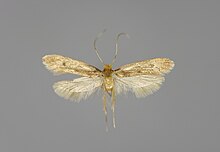| Case-bearing clothes moth | |
|---|---|

| |
| Case with pupal skin (above) Adult moth (below) | |

| |
| Museum specimen | |
| Scientific classification | |
| Domain: | Eukaryota |
| Kingdom: | Animalia |
| Phylum: | Arthropoda |
| Class: | Insecta |
| Order: | Lepidoptera |
| Family: | Tineidae |
| Genus: | Tinea |
| Species: | T. pellionella |
| Binomial name | |
| Tinea pellionella Linnaeus, 1758 | |
| Synonyms | |
| |
Tinea pellionella, the case-bearing clothes moth, is a species of tineoid moth in the family Tineidae, the fungus moths. This species has a cosmopolitan distribution, occurring nearly worldwide.
Taxonomy
Being a widespread species and often affiliated with humans, T. pellionella was among the first moths to be scientifically described in the modern sense. At that time most moths were included in a single genus "Phalaena", but Tinea was already recognized as a distinct subgenus. Some later researchers who studied this moth erroneously believed they had discovered populations formerly unknown to science and described them as new species, but today these are all included within T. pellionella. Obsolete scientific names for this moth thus may be encountered in the literature, and include:
- Phalaena (Tinea) pellionella Linnaeus, 1758
- Phalaena zoolegella Scopoli, 1763
- Tinea demiurga Meyrick, 1920
- Tinea gerasimovi Zagulajev, 1978
- Tinea pelliomella (lapsus)
It is the type species of the genus Tinea, which in turn is the type genus of the subfamily, family, as well as the superfamily Tineoidea. Its scientific name is derived from "tinea", a generic term for micromoths, and the Latin term for a furrier, pellionellus.
Another common name is "bagworm" due to the case that their larvae carry around, but not to be confused with the Psychidae that are also called "bagworms" in English.


Description
It is silvery grey to shiny light brown in color, with dark grayish hairs on the top of its head. The adult of this species has a wingspan of 9 to 16 millimeters. Its forewings are grizzled brown with one large spot and a few smaller, indistinct black spots. The hindwings are plain pale brown-grey. The forewings, but especially the hindwings are surrounded by a hairy fringe.Difficult to distinguish from Tinea columbariella, Tinea dubiella and Tinea svenssoni but the genitalia are diagnostic.
The larva eats mainly fibrous keratin, such as hairs and feathers. It can become a pest when it feeds on carpets, furs, upholstery, and woolen fabrics. It also consumes detritus, cobwebs, bird nests (particularly of the domestic pigeon), stored vegetable produce and wallpaper. It stays inside a snug case it constructs from debris such as fibers and hairs.
Biology
It is synanthropic; the adult is typically encountered during summer and early autumn, but populations that live in human dwellings may be seen at other times of the year.
Control measures for the case-bearing clothes moth are similar to those for the common clothes moth (Tineola bisselliella), and include physical, chemical, and biological measures.
References
- Cheema, P. S. (March 1956). "Studies on the Bionomics of the Case-bearing Clothes Moth, Tinea pellionella (L.)". Bulletin of Entomological Research. 47 (1): 167–182. doi:10.1017/S0007485300046605. ISSN 0007-4853.
- "The Tineidae Database at the Natural History Museum". Natural History Museum. 2016-03-03. Archived from the original on 2016-03-03. Retrieved 2024-04-03.
- Museum, Natural History; Pitkin, Brian; Jenkins, Paul (2023-02-17). "Butterflies and Moths of the World". Natural History Museum Data Portal. doi:10.5519/s93616qw.
- "Australian Faunal Directory: Species Tinea pellionella Linnaeus, 1758". Australian Government Department of the Environment. 2012-02-27. Archived from the original on 2015-09-24. Retrieved 2015-09-24.
- "Taxon Details - Tinea pellionella Linnaeus 1758". Fauna Europaea. 2011-01-27. Archived from the original on 2012-10-18. Retrieved 2012-10-18.
- "Tinea pellionella | insectslimited". Archived from the original on 2013-12-03. Retrieved 2013-09-08.
- Pelham-Clinton E.C., 1985.Tineidae. In: The Moths and Butterflies of Great Britain and Ireland (Heath J & Emmet AM, eds) 2: 152-207.
- Zagulajev, A.K., 1990 Tineidae ; in G.S. Medvedev (ed.): Keys to the insects of the europaean part of the USSR, Vol.IV: Lepidoptera, part 2 (english translation), Oxonian Press Pvt.Ltd., New Dehli, 1987
- ^ "Case-bearing Clothes Moth Adult | UKmoths". ukmoths.org.uk. Retrieved 2024-04-03.
- Grabe, Albert (1942). "Eigenartige Geschmacksrichtungen bei Kleinschmetterlingsraupen" [Strange tastes among micromoth caterpillars] (PDF). Zeitschrift des Wiener Entomologen-Vereins (in German). 27: 105–109.
- Gaedike R., 2019, Reinhard (2019). 2019 Tineidae II : Myrmecozelinae, Perissomasticinae, Tineinae, Hieroxestinae, Teichobiinae and Stathmopolitinae Microlepidoptera of Europe, vol. 9. Leiden : Brill. Microlepidoptera of Europe. Leiden: Brill. ISBN 978-90-04-38750-8.
{{cite book}}: CS1 maint: numeric names: authors list (link) - Petersen, Günther (1957-11-30). "Die Genitalien der paläarktischen Tineiden (Lepidoptera: Tineidae)". Beiträge zur Entomologie = Contributions to Entomology (in German). 7 (5–6): 557–595. doi:10.21248/contrib.entomol.7.5-6.557-595. ISSN 2511-6428.
External links
| Taxon identifiers | |
|---|---|
| Tinea pellionella |
|